- Submissions

Full Text
Evolutions in Mechanical Engineering
Relation Curves of Force with the Cutting Parameter of Hole Milling
Umair Riaz1,2, Can Liu1* and Muhammad Junaid Saeed1
1Department of Mechanical Engineering and Power Engineering, Zhanjiang, China
2University of Central Punjab, Lahore, Pakistan
*Corresponding author:Can Liu, Department of Mechanical Engineering and Power Engineering, Zhanjiang, China
Submission: May 14, 2019; Published: June 19, 2019

ISSN 2640-9690 Volume2 Issue5
Abstract
The milling cutting forces were analyzed through average milling forces to see the relation curve of force with a cutting parameter. This research carried out through accomplishment many experiments of hole milling on CNC milling machine. The operation was done with variable cutter diameter and hole diameter at different spindle speed. In this paper, the spectrum analyzes in the form of time domain and frequency domain using Matlab software (v, r2014b) through DFT (Discrete Fourier Transform) signal processing tool. Observation showed that Fz is the largest and increasing the speed of the cutter as it falls in one of the most dominant components among the Fx, Fy, and Fz. Hence conclude by the result that the 12mm cutter diameter and hole diameter 16mm are the best because the cutting force is minimal. This study can be used in the research of cutting forces of hole milling for further investigation. Hole making frequently uses a drill, a hole in High-Speed Milling we can make the milling hole, the hole can be manufactured by milling. So inner cooling might be valuable in milling hole in HSM.
Keywords: Cutting force; Inner cooling; Outer cooling; Hole milling
Introduction
In machining, hole milling is used for the cylindrical element is cut from the workpiece by cutting tool which enters into the workpiece by axially working axis. In the milling cutter, three forces are acting on the tool, called 1. Tangential cutting forces, 2. Radial cutting forces 3. Axial cutting forces. Tangential forces are the most important to study because tangential forces are 70% of the total force. The radial forces are 20%, and axial forces are 10% of the entire forces. Inner cooling is a method of applying the liquefied through the internal canal of the tool, and outer cooling is a technique of applying fluid straight on the workpiece through external station or nozzles. Wang et al. [1] Done the experiments with four milling methods on Carbon Fiber Reinforced Polymer composite/Ti stack material. The main objective of this study was to find an improved way of milling hole. Results showed that axial forces have a linear relationship with the feed rates and an inverse relationship with the spindle speeds. Lihong Wen, Guanghui Li, Ningxia Yin, and Guangyu Tan presented the article “Simulation Research on Tool Temperature Field in High-Speed Inner Cooling Milling” in which they suggested that in inner cooling milling at the spindle speed of 10,000-12,000 rpm the inner cooling cutting has a more significant decline of temperature than the dry cutting. The inner cooling milling tool suffers not only cutting force caused by interrupted cutting but also the same frequency of thermal shock at the same time. The thermal cracks are generated and eventually lead to tool damage at the condition of alternating stress. Although the cutting fluid can cool and lubricate the cutting milling tool, at the same time it can cause hot crack because the inner milling tool bears cyclic heating and cooling as it is cutting in and out of the workpiece[2]. Can et al. explored the comparative study on the cutting forces using up and down milling with T10 hardened steel. Theoretical Force model was derived for this purpose and reported that maximum component force in down and up milling was in the direction of radial cutting depth and feed respectively. In up milling, the effects of velocity, axial cutting depth, and feed are highly significant. Moreover, the maximum force in down milling was significantly higher than in up milling [3]. In the article “Analytical Cutting Forces Model of Helical Milling Operations”, by Changyi Liu [4] recommended that during demonstrating cutting forces of drilling, the axial feed was not measure, the aim is that the edge of the twist drill has a taper angle, the interaction between the tip and workpiece produced by spindle rotation would lead to the axial force unexpectedly Zhongqun Li et al. [5] explored the cutting force model for developed for hole-making operation by helical milling in which the diameter of the cutting tool is less than that of the machined hole. Yagishita H et al. [6] reported that in hole making by circular milling supplying oil fog through the axial hole of spindle and end mill is powerfully effective to progress the precision of hole diameter and roundedness. Liu C et al. [7] noted that, the effects of feature analysis for milling force of three-edge end mills.
Results indicate that the proportion of radial force to tangential force has rather an excessive impact on the structures of force. In the research paper “Study on Prediction Models of Milling Force for T10 Hardened Steel,” it was concluded that equations of milling force in low-speed and high-speed milling are different and force arc of milling T10 hardened steel looks at around 100m/min of speed Yin N et al. [8] Did the work on feed system in internal cooling and reported the design of lubricant feed system, a direct cutting fluid into the tool-chip boundary should have had preferred for inner cooling end milling cutter. In accumulation to the adjustable flow of the cutting fluid, the feed liquid pressure and the cleanness of the cutting fluid should be considered, and it as well helps toward final cost [9]. Helical milling goes to be a feasible substitute to conventional drilling for the hole machining in low machinability materials such as the Inconel 718 since its demonstrations great flexibility and precision to adjust to the desired diameter, and as a result, the machined insincere quality is superior. Machined hole quality would increase in terms of surface roughness [10].
During the entire study process, we originate that cutting forces is a vital factor that would be further investigate in depth and there should be a rule which tells us, which tool diameter could we can if we need inner cooling. The purpose of this editorial is to examine the study on hole milling of inner cooling and outer cooling which is based on cutting forces. The content of this paper is to do the experiments of milling and to do the analysis and conclusion of cutting forces.
Experiments Cutting Parameters Design
We will use hole milling. All analyses were completed on a Computer Numerical Control (CNC) milling machine (Figure 1) with had a maximum speed of 20000RPM. The SDC-C4F dynamometer (Figure 2) connected to the BZ7201B strain amplifier (Figure 3). The strain amplifier synthetic by Qinhuangdao beidaihe Lande science and technology Co., Ltd. The dynamometer had a 0-1500 N cutting range with 3kHz natural frequency in X, Y direction. The sensitivity for the dynamometer/gauge 133.3 N/V. The subdirectory was download from strain amplifier, and information about cutting forces was saved into the personal computer (Figure 4). The cutting material (T10 harden steel, HRC 40) was attached on the dynamometer. The milling cutter used for the measurement was flat end mill cutter (material tungsten carbide). The cutter diameters were customary as 10mm, 12mm, 16mm, and 20mm, as shown in the temporary table with feed per tooth was 0.05mm/ tooth, and the spiral lead was 0.5mm same during the experiment (Figure 5). Firstly, every preliminary reading in the initial table was done for the inner and outer cooling with a spindle speed 540rpm with sampling frequency 2160Hz, at different hole diameters as shown in the experimental Table 1. Secondly, the preliminary reading in the preliminary table was done for the inner and outer cooling with a spindle speed 1080rpm with sampling frequency 4320Hz, at different hole diameters as shown in the experimental table. The experimental Table 1 was consisting of two reading (Inner and outer cooling) at cutter diameter 20mm, and the hole diameter was 24mm (Figure 6). The difference in experiment Table 1 & 2 was feed rate and milling basis on the previous milling. Since in this experiment, we were using hole milling so the cutting forces, an analysis, will be combined cutting forces wavelength in feed and cutting width direction (x, y-direction).
Figure 1:CNC milling machine.
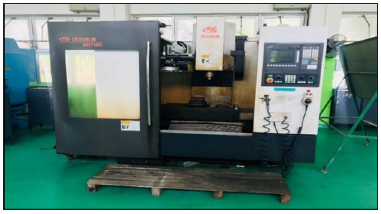
Figure 2:SDC-C4F dynamometer.
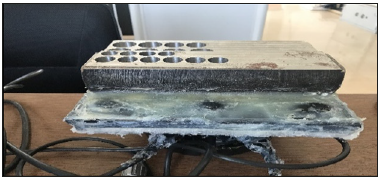
Figure 3:Strain amplifier.
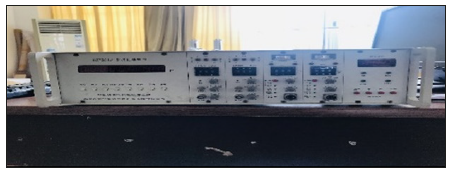
Figure 4:Personal computer.

Figure 5:Experimental arrangement through 3D model.
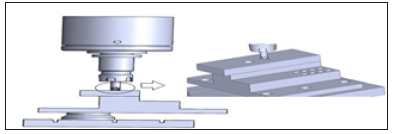
Figure 6:Graph b/w speed v/s A.S.
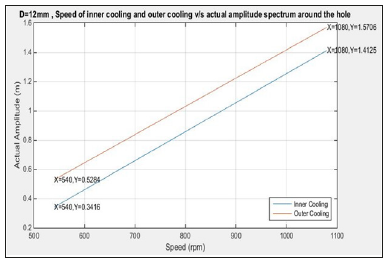
Table 1:Experimental reading.

Table 2:Experimental reading.

Milling on the base of Test # 3 and 11 milling holes.
Analysis
The Subdirectory was examined in Matlab software. The frequency domain spectrum was developed through Fourier transform tool FFT. The average cutting forces were in x, y and z-direction initiate from using the Matlab command A=mean (x), B=mean (y), C=mean (z). Afterward noted these cutting forces data, compared the data with each other (Figure 7). For some reading, the amplification was not the same. So, the actual force can’t be compared with different amplification force data. It’s desired to convert the actual force with the same amplification for analyzing the results. The unit of this actual force was in Voltage. Since the sensitivity for the dynamometer 133.3 N/V. So, we have to transform into NEWTON. When the amplification is 1. Sensitivity=133.3 N/V. When amplification 2. Then S=133.3/2=66.65 N/V and so on. We are interested in getting the force-frequency which remove the material of a level or one complete circle.
Figure 7:Graph b/w speed v/s A.S.
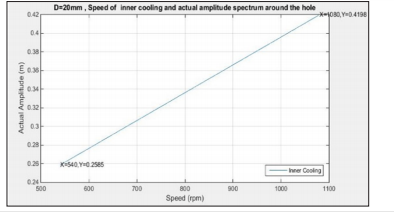
Figure 8:Wavelength in time domain.

Table 3:Actual spectrum amplitude.

Since we see the time to cut a circle level is 6.98 sec for speed 540rpm and 3.49sec for 1080rpm, we recognize the relation f=1/T. The theoretical force frequencies are 0.1432Hz and 0.2865Hz (Figure 8). The frequency cutter around the hole is very little than spindle frequency [10]. We can compare these theoretical force frequencies with experimental force frequency in the frequency spectrum of each data. The amplitude of these force frequency also noted down. This spectrum amplitude will not give you the actual spectrum amplitude. Since we calculate the cutting forces when the material and tools are in contact with each other le 3). We have indeed removed some portion so to find the actual spectrum amplitude the amplitude of the frequency of cutter around the hole should be divided by the number of data points we used to calculate the cutting forces.
Discussion
From the analysis data, we observed that for the forces in x-direction increase along the hole, but x-direction forces are not so significant, but a force in the z-direction is very substantial. With the speed increase, forces also increase very significantly (Figure 9). For low speed, the maximum force of outer cooling is 115.42 but for high speed for outer cooling maximum force is 370.38 about four times which means for outer cooling comparison speed increase twice the maximum forces increase about four times. For inner cooling, it should also be distended. For inner cooling speed increase, twice forces increase twice also (Table 4).
Figure 9:Cutting force v/s hole diameter.

Figure 10:Cutting force v/s hole diameter.

Table 4:Average cutting forces in the z-direction

If we increase the feed, the forces should also increase. In our case, if we increase the feed on the beginning of the previous hole with same hole depth the forces in y-direction will increase. But if mill the hole before with smaller diameter, then increase the diameter, the forces will not great because the bottom edge of cutter won’t cut (Figure 10).
Conclusion
As the speed of inner or outer cooling increases, the forces in milling also increases. The depth of cut will increase as the cutter descends, especially during outer cooling, force is significant, and the inner cooling force rises a little. Inner cooling is better than outer cooling, especially when the hole depth is not high, but when the depth increases, the inner cooling is not that significant. The results show that the chip cannot flow out because it breaks; even the chip breaks force is smaller than the outer cooling. Milling cutting forces will increase with speed. The relationship between the hole diameter and the cutter diameter is direct, and the milling cutting forces are increased gradually for the low speed while, but not for high-speed results. The 12mm cutter diameter and hole diameter 16mm are the best because the cutting force is very small. For 3-D forces, the axial force Fz, which is resultant of the component force from the cutting tool, is significantly higher than that of Fx and Fy, The same fact is that Fz is the largest, and increasing the speed of the tool as it falls is one of the most essential components that we cannot ignore.
Acknowledgment
This research was supported by the National Natural Science Foundations of China NSFC Founded in 1986 (Grant Number 51375099, 51375100).
References
- Wang G, Kirwa S, Li N, Peng T, Li Y (2018) Composite Structures 200(37): 679-688.
- Liu C, Tan GY, Li GH, Liang JS, Li DR (2010) Advanced Materials Research 136: 108-113.
- Zhongqun LI, Qiang LIU, Chong P, Xiao SUN (2011) Proc. of SPIE 7997: 1-6.
- Yagishita H, Osawa J (2016) Procedia Manufacturing 5: 195-204.
- Liu C, Wang G, Dargusch M (2011) World academy of science. Engineering and Technology 59: 1082-1087.
- Yin N, Li G, Tan G, Shen C, Xue J (2018) IOP Conf. Series: Journal of Physics.
- Olvera D, Rodríguez CA, Elías ZA (2012) Machining Science and Technology.
- Wen L, Li G, Yin N, Tan G (2018) Advances in mechanical design 1025- 1035.
- Wu J, Li G, Liu C, Tan G (2011) Solid state phenomena 175: 342-346.
- Liu C, Li G, Wu J, Tan G (2011) Advanced materials research 193: 3079- 3083.
© 2019 Can Liu. This is an open access article distributed under the terms of the Creative Commons Attribution License , which permits unrestricted use, distribution, and build upon your work non-commercially.
 a Creative Commons Attribution 4.0 International License. Based on a work at www.crimsonpublishers.com.
Best viewed in
a Creative Commons Attribution 4.0 International License. Based on a work at www.crimsonpublishers.com.
Best viewed in 







.jpg)






























 Editorial Board Registrations
Editorial Board Registrations Submit your Article
Submit your Article Refer a Friend
Refer a Friend Advertise With Us
Advertise With Us
.jpg)






.jpg)














.bmp)
.jpg)
.png)
.jpg)










.jpg)






.png)

.png)



.png)






